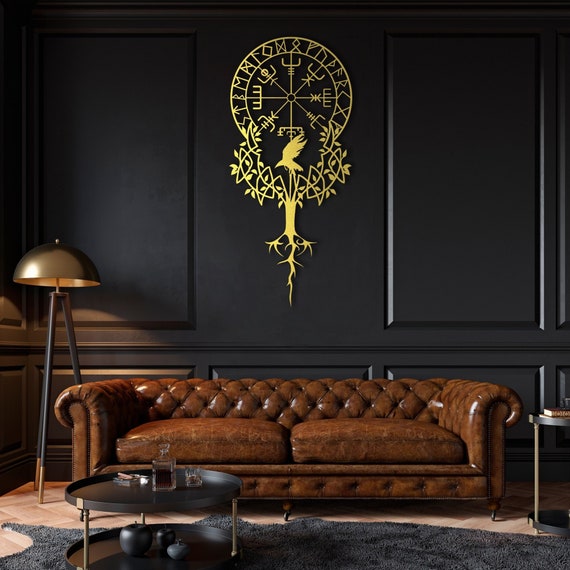Norse home decor has gained significant popularity in recent years, and for good reason. This style, steeped in rich history and mythology, offers a unique aesthetic that can transform any living space. Whether you’re a history buff, a fan of Scandinavian design, or simply looking for a fresh take on home decor, Norse influences can provide that special touch. In this article, we’ll explore various aspects of Norse home decor, share personal experiences, and offer practical tips to help you create your own Viking-inspired haven.
What is Norse Home Decor?
Norse home decor draws inspiration from the Viking Age and Norse mythology. It combines natural elements, rugged textures, and earthy colors with artistic motifs from ancient Scandinavian cultures. This style often features materials such as wood, stone, and leather, creating a warm and inviting atmosphere reminiscent of ancient longhouses.
The Basics of Norse Design Principles
- Natural Materials: Emphasizing wood, stone, and textiles.
- Color Palette: Earthy tones, deep blues, greens, and rich browns.
- Mythological Motifs: Incorporating symbols and stories from Norse myths.
- Functional Aesthetics: Merging beauty with practicality.

Key Elements of Norse Home Decor
1. Wood and Timber Accents

Wood is a central element in Norse decor. From furniture to wall treatments, it provides warmth and a natural touch. Consider reclaimed or rustic wood furniture pieces that echo the craftsmanship of the Viking Age.
Types of Wood to Consider
| Wood Type | Description | Pros | Cons |
|---|---|---|---|
| Oak | Durable and strong, ideal for furniture. | Long-lasting, classic look. | Can be expensive. |
| Pine | Lightweight and easy to work with. | Affordable, creates a rustic feel. | Less durable than hardwoods. |
| Birch | Sleek grain pattern, great for cabinetry. | Beautiful finish, strong and resilient. | Can be pricey depending on quality. |

2. Rich Textiles
Textiles play a significant role in achieving an authentic Norse look. Look for wool or linen fabrics with intricate patterns or earthy colors. Throws, rugs, and cushions can help warm up your space.

Textile Ideas
- Fleece Throws: Perfect for chilly evenings.
- Woven Rugs: Add texture and comfort to floors.
- Pillows with Nordic Patterns: Incorporate traditional motifs.
3. Mythological Motifs

Norse mythology is filled with fascinating tales and symbols that can enhance your decor. Consider incorporating artwork, sculptures, or textiles that reference gods like Odin, Thor, or Freya.
Popular Norse Symbols
- Yggdrasil: The tree of life, representing interconnectedness.
- Mjölnir: Thor’s hammer, symbolizing protection and strength.
- Valknut: An emblem associated with Odin and the afterlife.

Creating Your Norse-Inspired Space
Step 1: Choosing Your Color Palette

Start with a color palette that reflects the Norse aesthetic. Earthy tones are essential. Consider deep greens, browns, and blues, which evoke the Scandinavian landscape.
Step 2: Furniture Selection
Opt for wooden furniture with clean lines and rustic finishes. Mix different wood species for a layered look. Large dining tables made from reclaimed wood can serve as a centerpiece.
Step 3: Accessorize Thoughtfully
Accessories are where you can really express the Norse influence. Look for pottery, carved wooden trinkets, or even replica Viking shields to add character to your space.
Step 4: Lighting Choices
Lighting can dramatically change the mood of a room. Use wrought iron fixtures or lantern-style lamps to create a warm, inviting glow.
Personal Experience: My Journey into Norse Home Decor
When I first ventured into the world of Norse home decor, I felt a deep connection to the history and stories behind it. I started with small elements—a wooden wall hanging featuring a Viking ship and a cozy woolen throw. As I continued to explore, I incorporated more artifacts like a handcrafted wooden bowl and a wall mural depicting Yggdrasil. Each piece told a story and brought a sense of warmth and authenticity to my home.
Pros and Cons of Norse Home Decor
Pros
- Unique and meaningful aesthetic.
- Timeless elements that blend well with other styles.
- Encourages the use of sustainable materials.
Cons
- Can be challenging to source authentic pieces.
- May require a significant investment for quality items.
- Some may find the style too rustic for modern tastes.
Frequently Asked Questions (FAQs)
1. What are some easy ways to incorporate Norse decor into my home?
Start with small accessories like cushions or artwork featuring Norse motifs. You can gradually introduce larger elements like furniture or textiles.
2. Is Norse decor suitable for small spaces?
Absolutely! Focus on selecting multi-functional furniture and using light colors to create an open feel, while still incorporating Norse elements into accessories.
3. Can I mix Norse decor with modern design?
Yes! Norse decor pairs beautifully with modern elements, creating a unique blend that can make a statement in your home.
4. Where can I find authentic Norse home decor items?
Look for local artisan markets, online shops specializing in Scandinavian or Norse decor, or even thrift stores that might have vintage pieces.
5. What are some common mistakes to avoid in Norse home decor?
Avoid overwhelming a space with too many motifs. Instead, focus on a few key pieces that highlight the Norse theme without cluttering your decor.
Conclusion
Norse home decor is more than just a trend; it’s a way to connect with history while creating a cozy and inviting atmosphere. By incorporating natural elements, rich textiles, and mythological motifs, you can transform your space into a Viking-inspired retreat. Take your time to choose pieces that resonate with you personally, and remember that every item tells a story. Happy decorating!